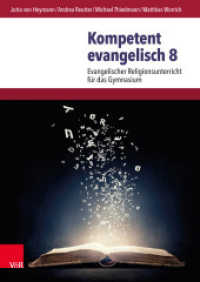Full Description
This edition presents 33 of the 100 tales, with at least two from each of the ten days of storytelling. Boccaccio's general introduction and conclusion to the work are also included, as are the introduction and conclusion to the first day; the reader is thus provided with a real sense of the Decameron's framing narrative. Extensive explanatory notes are provided, and the volume is prefaced by a concise but wide-ranging introduction to Boccaccio's life and times, as well as to the Decameron itself. A unique selection of contextual materials concludes the volume.
Contents
Acknowledgments
Introduction from The Decameron
The Author's Preface
Introduction to the First Day
The First Day
I. Story 1: Cepparello's False Confession
I. Story 2: The Jew who Sees Rome and Converts
I. Story 3: Melchisedech and the Tale of the Three Rings
I. Story 5: The King of France and the Banquet of Hens
I. Story 10: Master Alberto Shames the Woman who Refuses his Love
Conclusion to the First Day
The Second Day
II. Story 5: Andreuccio's Three Misadventures in Naples
II. Story 7: The Sultan's Daughter Sleeps with Nine Men and Returns a Virgin
The Third Day
III. Story 1: Masetto becomes Gardener to a Convent
III. Story 6: Ricciardo sends a Jealous Wife to the Baths to catch her Husband
III. Story 8: Ferondo visits Purgatory
III. Story 9: Giletta of Narbonne
III. Story 10: Alibech and Rustico put the Devil back into Hell
The Fourth Day
Introduction
IV. Story 1: Tancredi, Ghismunda, and her Lover's Heart
IV. Story 2: Frate Alberto as the Angel Gabriel
IV. Story 5: Lisabetta and the Pot of Basil
IV. Story 8: The Broken Hearts of Girolamo and Salvestra
The Fifth Day
V. Story 1: Cimone and Lisimaco Abduct their Brides
V. Story 4: The Lovers, the Balcony, and the Nightingale
The Sixth Day
VI. Story 1: Madonna Oretta and the Story Ride
VI. Story 4: Chichibio and the One-legged Bird
VI. Story 7: Donna Filippa Confronts the Adultery Laws
VI. Story 9: Guido Cavalcanti's Witty Escape
The Seventh Day
VII. Story 2: Peronella's Lover and the Barrel
VII. Story 6: A Quick-Thinking Adulteress
The Eighth Day
VIII. Story 3: Calendrino and the Heliotrope Stone
VIII. Story 7: The Scholar Frozen and the Lady Burned
The Ninth Day
IX. Story 5: Calandrino in Love
IX. Story 6: Three Beds and a Cradle
IX. Story 10: The Spell that Turns Women to Mares
The Tenth Day
X. Story 3: Nathan Offers his Life
X. Story 5: A Lady's Honour for a Garden in Winter
X. Story 8: The Perfect Friendship of Tito and Gisippus
X. Story 10: Griselda's Remarkable Patience
The Author's Epilogue
In Context
The Black Death
from Marchione di Coppo Stefani, from The Florentine Chronicle (ca. 1389), "Concerning the Black Death in the City of Florence, Mortal to Many People,"
The Black Death: fourteenth century images
Accounts of Boccaccio's Life
Giannozzo Manetti, "The Life of Giovanni Boccaccio"
Ludovico Dolce, "A Description of the Life of Messer Giovanni Boccaccio" (1552)
Sources and Antecedents
from Apuleius, The Golden Ass: from Book Nine, "The Lover in the Barrel" (c. 160 CE)
from Petrus Alphonsus, Disciplina Clericalis, "The Two Perfect Friends," (12th century)
from Andreas Capellanus, The Art of Courtly Love (c. 1180)
Anonymous, "Concerning a Priest and a Lady" (13th century)
from Anonymous, Il novellino (1281-1300)
How a king raised his son in darkness, then revealed to him all there was in the world, and how the boy found women above all things the most pleasing."
"How the Sultan in search of money tried to snare a Jew through litigation."
"The never-ending story."
from Giovanni Boccaccio, The Questions of Love: "The Fourth Question, as proposed by Menedon" (1335-36)
The Tale of Patient Griselda
from Francesco Petrarch, Letter to Boccaccio on "The Tale of Patient Griselda" (1373)
Anonymous, "A Most Pleasant Ballad of Patient Grissell" (ca. 1600)
Patterns of Influence
from Sir Thomas Elyot, The Book Named the Governour: from Bk. II, Chap. 12, "The Wonderful History of Titus and Gisippus, whereby is fully declared the figure of perfect amity." (1531)
from Giovan Francesco Straparola, The Pleasant Nights (Piacevoli notti) (1550, 1553)
from the Proem
Rodolino and Violante, or The Broken Hearts
Illustrations to the Decameron








